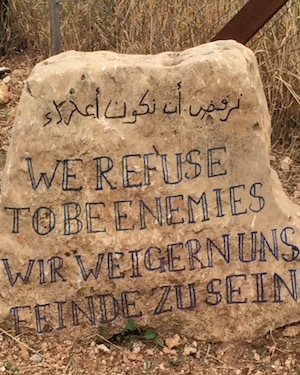A Response to “Risking Peace” and the Peace Fellowship’s Proposals

The forthcoming General Assembly is facing a number of issues with important consequences for the present and future identity of the Church. While the two issues that have created the greatest pre-assembly discussion are whether to permit Presbyterian ministers to officiate at same sex marriages and whether or not to divest from 3 companies doing business that aid Israel’s settlements in Palestinian territory, perhaps the question with greatest importance for thinking about the nature of the Church centers around how the General Assembly with act on the so-called peace discernment process.
An extensive and thoroughly worked-over report from the Advisory Committee on Social Witness Policy (ACSWP) entitled “Risking Peace in a Violent World: Affirmations for Presbyterian Consideration” (Item 11-11) will be considered, along with an overture from the Presbytery of Baltimore (Item 11-01) “An Overture on Peace Discernment.” This article is a modest and perhaps belated effort to further the process of dealing with these important proposals.
___________________________________________
In working through these difficult issues, it is important to acknowledge the limitations of any one approach.
___________________________________________
Both documents seek to strengthen the peacemaking thinking and program of the Church, but they differ in their assumptions regarding the underlying theological premises for doing so and in the extent to which they envision a transformation of the Church’s self-understanding. The “Risking Peace” document, which has been several months in preparation, proposes five affirmations to be sent to presbyteries for discussion, requesting responses (by vote) to be returned to the 2016 General Assembly for further action. Presumably this process would eventually give the moral stances expressed in these affirmations a unique standing – something more definitive than a social witness policy of a single General Assembly but something somewhat less obligatory than an addition to the Church’s Book of Creeds.
 Somewhat in contrast the overture from the Presbytery of Baltimore calls for the PC(USA) to embrace nonviolence as its fundamental response to the challenges of social turmoil such as violence, terror, and war–presumably as an action of this General Assembly.
Somewhat in contrast the overture from the Presbytery of Baltimore calls for the PC(USA) to embrace nonviolence as its fundamental response to the challenges of social turmoil such as violence, terror, and war–presumably as an action of this General Assembly.
The decision that this General Assembly makes on these two documents will have a long and fundamental impact on the faith and commitment of the Church.
My hope is that there are many members of the Church who believe the General Assembly should take some action to extend the concern for peacemaking that has been a distinctive and valuable feature of the PC(USA)’s social witness for the last quarter of a century and more. This Assembly action, I believe, should make the peacemaking concern more explicit and emphatic, more diligent and vigorous, of greater relevance to a world and to a nation in which conflict and violence have not diminished but have actually intensified in form and frequency since the foundational peacemaking policy “Peacemaking: The Believers Calling” (1980) was written and adopted many years ago. The immediate issue will be which of the models for expanding our peacemaking initiatives being brought to the standing committee has the greatest warrant and whether or not they can be made to work together.
___________________________________________
Saying nonviolence is fundamental leaves open the possibility that rare and unusual circumstances may call for the use of properly restrained force, which just war thinking has always held.
___________________________________________
The “Risking Peace” document has been through a long refining process in which the deep and troubling good-faith differences of judgment about the ethics of war and peace have been discussed by many thoughtful participants and onlookers. The steering committee’s original version seemed to some, myself among them, to be overly weighed toward a pacifist set of assumptions about how to read the New Testament and how to understand the tradition of just war thinking. Its exegesis of the New Testament was something of a literalism on the left–citing only biblical authorities that were sympathetic to the view that the teachings of Jesus and practice of the early church provided unequivocal support for the contention that Christians must repudiate all uses of violence in order to be faithful. Those premises were used to argue for the view that peacemaking must be based upon the categorical repudiation of violence and the assumption that the loophole for supporting violence in extreme circumstances that developed with just war theory was a key reason why the witness of the Church against national policy was ineffective in stopping wars.
 When this early draft was shared for comment with members of a group of Presbyterians Christian Ethicists (known as the Social Ethics Network), a number of the members were of the opinion that the paper needed to be revised. It seemed weighted too heavily toward the so-called “Peace Church Tradition” in which the repudiation of violence is a central feature of the heritage. That tradition contrasts with the main stream of the Reformed tradition (and also the Roman Catholic heritage) which acknowledges that when Christians become responsible for society rather than outcasts from it, they may be called in rare and extraordinary conditions to use coercive means to protect persons threatened with harm or social order threatened with anarchy.
When this early draft was shared for comment with members of a group of Presbyterians Christian Ethicists (known as the Social Ethics Network), a number of the members were of the opinion that the paper needed to be revised. It seemed weighted too heavily toward the so-called “Peace Church Tradition” in which the repudiation of violence is a central feature of the heritage. That tradition contrasts with the main stream of the Reformed tradition (and also the Roman Catholic heritage) which acknowledges that when Christians become responsible for society rather than outcasts from it, they may be called in rare and extraordinary conditions to use coercive means to protect persons threatened with harm or social order threatened with anarchy.
Memos were prepared and transmitted to the steering committee pointing to these concerns, and these were met with appreciation even if not always with agreement. Included in the points raised was the observation that just war thinking has not always been used to sanction violence, but was the basis on which many Christians came to oppose modern wars such as the war in Vietnam. The result is that the present formulation of the five affirmations and the supporting arguments in the background paper have been modified in such a way as to leave open the possibility that people of good faith who have different views on the morality of war can nevertheless embrace a set of affirmations that strengthen the premises of peacemaking as a calling.
___________________________________________
It is not difficult to understand why this approach does not seem satisfactory to some Church members who are deeply committed to the idea that a decisive and unflinching moral obligation to nonviolence is the only legitimate behavior in conflict.
___________________________________________
To be sure, this process has not eliminated the differences of judgment nor managed to reconcile them perfectly with each other. But let us remember that the “Risking Peace” document is not being offered as a declaration of final assertions as to the contours of a Christian calling. It does not propose to delineate the one proper way to think about peacemaking. It suggests further thought and discernment, not a single defining stand by which Christian fidelity is to be measured.
 It is not difficult to understand why this approach does not seem satisfactory to some Church members who are deeply committed to the idea that a decisive and unflinching moral obligation to nonviolence is the only legitimate behavior in conflict. People of this persuasion, I imagine, will be more inclined to favor the overture sent in by the Presbytery of Baltimore, which asks the General Assembly to declare that nonviolence should be the “fundamental” basis of Christian behavior.
It is not difficult to understand why this approach does not seem satisfactory to some Church members who are deeply committed to the idea that a decisive and unflinching moral obligation to nonviolence is the only legitimate behavior in conflict. People of this persuasion, I imagine, will be more inclined to favor the overture sent in by the Presbytery of Baltimore, which asks the General Assembly to declare that nonviolence should be the “fundamental” basis of Christian behavior.
There is nothing in the “Risking Peace” document that takes away the right of individual Presbyterians to understand Christian obligation in pacifist terms. That option has been strongly affirmed by the action of the 1967 General Assembly entitled But, I believe, there is a danger that the arguments associated with a contention that nonviolence is really the only legitimate basis of Christian behavior, will exclude other members of the Church holding different opinions.
Saying nonviolence is fundamental leaves open the possibility that rare and unusual circumstances may call for the use of properly restrained force, which just war thinking has always held. Arguing that non-violence is always and in all circumstances mandatory, both for the Church and for the society, is a different moral stance–the moral stance of so-called “peace churches.”
*****
Some pacifists within the PC(USA) have indicated that they are uncomfortable with some aspects of the five affirmations in the document “Risking Peace” and have asked for modest changes in their wording. These suggested changes have been set forth in a document being circulated by the Presbyterian Peace Fellowship. I will comment on them merely as an individual whose views may or may not be helpful. In my view, they or something very similar can be adopted without excluding members of the Church who hold other commitments
A.) Regarding the suggested change in first affirmation, which calls for dropping the term “unjustified violence.” This term is less helpful than it ought to be. Under just war thinking, it might apply to violence about which a moral consensus has developed declaring it immoral, or it might apply to the violence that is undertaken without the sanction of legitimate authority. It is insufficiently precise to be crucial. Moreover, it turns out that this term is read by some as excluding them because they hold that all force is unjustified, which may be its unintended consequence.
Dropping this term will not alter the fundamental position of the document but leaves in tact the present divided mind of the church – which won’t be brought to a consensus by any one declaration of General Assembly. I would not oppose dropping this term. This may have the effect of pushing the tone a bit more toward a pacifist perspective than is acceptable to some advocates of morally legitimate force, it does not decisively do so.
B. Regarding the suggested changers to the fourth affirmation. The purpose of this affirmation is to acknowledge to potential contributions of several different aspects of the tradition for peacemaking. It can be sharpened. I agree that the existing “drawing on the traditions of just war, just peacemaking, and active nonviolence” can be improved. The best possible phrase would commend essentially parallel or comparable stands or indicate how each has a unique role. Perhaps it can be reworded as follows:
We seek to understand both the nonviolent revolutions and armed struggles of our time through the Gospel of Peace by drawing on the pacifist strand in the Christian heritage (with its moral witness against all violent coercion); on just war thinking (which seeks to delineate between legitimate and illegitimate uses of coercion); on the idea of peacemaking (which examines the causes of conflict and how they can be overcome); and on active nonviolence (which offers resistance to injustice and oppression). This involves cultivating moral imagination through prayer, study, and engagement with both friends and enemies and recognizes the value of diverse forms of witness.
C. Regarding the fifth affirmation: I would suggest “work for nonviolent change unceasingly in all possible ways,” and leave it at that.
*****
In working through these difficult issues, it is important to acknowledge the limitations of any one approach.We are all tempted to think that if only everyone would conform to our recipe for proper actions, the Church would be strengthened and Christian social witness fully implemented. But idealism can be as guilty of demanding conformity as realism can be. Actions that seek too much agreement and conformity do not necessarily produce the most faithful church.
 There is much yet to be learned about what is the best form of peacemaking. This General Assembly has an opportunity to mandate a further process of discernment is which none of the different positions is allowed to preempt the process by imposing a predetermined parameter for correctness.
There is much yet to be learned about what is the best form of peacemaking. This General Assembly has an opportunity to mandate a further process of discernment is which none of the different positions is allowed to preempt the process by imposing a predetermined parameter for correctness.
Openness and humility in the search for fidelity call for greater effort and more sustained inquiry than specifying where discernment has to come out. Devising a rich and potentially fruitful further process of discernment is essential for the future of the Church and its fundamental and well-founded commitment to peacemaking. May the Spirit move the process both in the actions of the General Assembly and in the discernment process that follows.
*****
AUTHOR BIO: Professor Edward Long was a leading participant in the team that wrote “Peacemaking: The Believers’ Calling” (1980). He has written a number of books dealing, among other things, with the idea of ‘peacethinking’, he and has contributed to much of the church’s teaching on peace and international relations since the 1960’s.
Read Item 11-11: “Risking Peace in a Violent World: Affirmations for Presbytery Consideration”, the report of the Peace Discernment Committee, and Item 11-01: “On Peace Discernment” from the Presbytery of Baltimore.
Read more articles from The Road to Detroit: Issues of Social Justice Before the 221st General Assembly!





Unbound Social